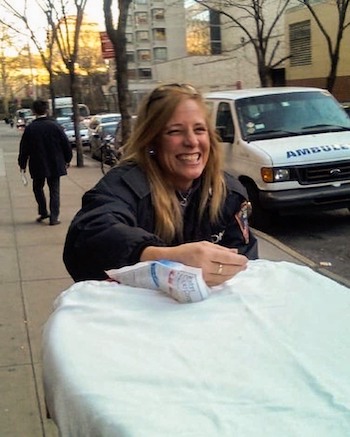Today, we honor workers who died on the job

 [/caption]
[/caption]AFSCME Local 3621 member Alison Russo-Elling, an emergency medical services lieutenant for the Fire Department of New York (FDNY), was less than a block from her worksite when she was stabbed in an unprovoked, random attack last September.
The 25-year FDNY veteran died in the hospital, making her one of perhaps thousands of workers to be killed in the line of duty last year. Today is Workers Memorial Day, when we honor workers like Russo-Elling who were killed in the line of duty.
In response to escalating workplace hazards, AFSCME and other national unions continue to push for stronger workplace safety protections through labor-management negotiations, legislation, worker education and regulatory enforcement.
With tremendous labor support, the Occupational Safety and Health Administration (OSHA) was established April 28, 1971, within the U.S. Department of Labor. In 1982, AFSCME Secretary-Treasurer Bill Lucy said at an AFL-CIO conference, “As things stand, some 14,000 men and women are killed on the job each year. They are crushed, mangled, electrocuted, gassed, strangled, incinerated and blown to pieces.”
When the federal government created OSHA, AFSCME fought to have all employees – private, public and governmental workers alike – covered by the new safety regulations. OSHA only sets the minimum standards needed for worker protection, establishing baseline safety procedures for employers to follow.
Not everyone is covered. OSHA covers private employers. Only in 22 states or territories are there OSHA-approved plans covering state and local government workers. Public employees in 23 states are still not afforded full OSHA protections. Unions and safety coalitions (like the national and state Council for Occupational Safety and Health, or COSH, groups) have been fighting to extend, expand and strengthen worker protections since OSHA was created.
AFSCME President Lee Saunders said in a statement that boosting job safety is a big reason why workers need to organize.
“Every safety regulation or protection on the books only happened because working people stood together to say enough is enough. It’s imperative that we continue to organize for safe workplaces – including safe staffing ratios, training, personal protective equipment and more. We must also continue to fight for permanent workplace protections against infectious disease, workplace violence and heat illness,” he said.
Staffing shortages are also increasing safety risks for overworked employees, he noted.
“From corrections facilities to hospitals to veterans’ centers, public service workers are facing dangerous staffing shortages that threaten their health and safety. This is having devastating impacts on our communities, as employers struggle to keep workers on the job because working conditions are so strenuous,” Saunders said.
Workplace fatality rates have come down significantly since 1982, when Bill Lucy wrote about the many ways workers were killed on the job.
But American workers are still getting killed and injured at work far too frequently, with disordinate impacts on communities of Black, Latino and immigrant workers, according to the AFL-CIO.
Fatalities due to chronic exposures to toxic substances and airborne respiratory diseases such as COVID-19 have never been fully counted. If those illness fatality numbers were included, total workplace fatality rates would jump exponentially – even more than they jumped from 2020 to 2021, during the height of the pandemic, when they spiked by 9%, according to BLS data.
According to the Federal Bureau of Labor Statistics (BLS), there were an average of 7.4 deaths per 100,000 full-time workers in 1982, and by 2021 that rate was down to 3.6 deaths per 100,000. The BLS reported 5,190 workplace fatalities in 2021, the latest year for which annual statistics were available.
That means a worker died on the job every 101 minutes. It’s still way too high.
